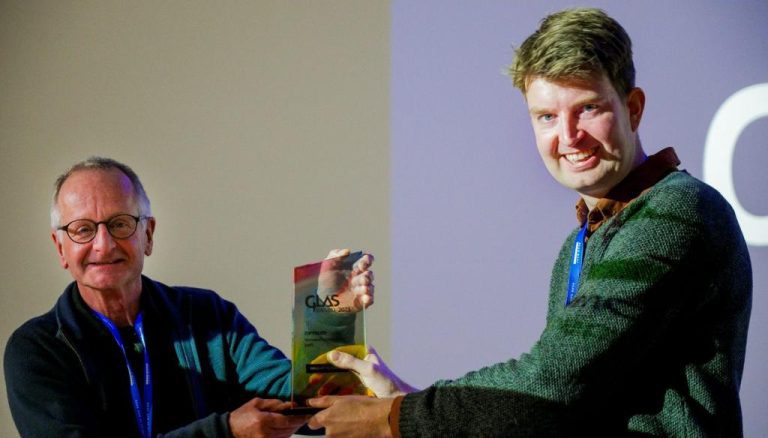Fun, beauty, education, mechanics, craftsmanship. Many things come together in the award-winning glass structure ‘Ziptruss’. Delta spoke to Ate Snijder, one of the designers.
The Ziptruss may look like a bundle of fluorescent tubes, but it is far from fragile. (Photo: Architecture/TU Delft)
Ate Snijder and his tutor Professor Rob Nijsse (Faculties of Architecture and the Built Environment, and Civil Engineering and Geosciences) have already pulled off stunning feats with structural glass – glass that bears forces. They have already built a bridge, a turret and a swing from glass. But for last year’s Glasstec 2022 trade fair (22-25 October 2022 in Düsseldorf, Germany), they wanted to outdo themselves and create something that would outshine their specialist brethren from Dortmund, Darmstadt and Dresden. One of the biennial fairs was cancelled because of Covid and that gave them time to make something special.
Ziptruss makes internal forces visible. Magic or technology? (Video: Oculus Film)
It had to be something big, something interactive that once again was also related to education at TU Delft. Thus an idea was born for a 14 metre long glass truss construction with a zip line underneath. That became the Ziptruss.
You can hang from it with your full weight and swing from one end to the other. As you do so, the glass tubes above your head change colour, depending on the load: red for pull, blue for pressure. “We have made invisible forces visible,” says Snijder.
Besides this educational model, the Ziptruss also features a spectrum of light shows for which Mechanical Engineering student Koen Bakker went all out on the programmable Arduino. After returning to the Netherlands, the Ziptruss won the Glass Innovation Award 2023 from Koninklijk Bouwend Nederland Vakgroep GLAS.

Rob Nijsse and Ate Snijder with the Glass Innovation Award. (Photo: Koninklijk Bouwend Nederland)
The magic is in the 1.6 metre long tubes, reveals Snijder. These are 120 millimetres in diameter and nine millimetres thick. On the inside is a transparent coating that holds the glass together after breakage. About half of the original pressure load then remains.
Inside the tube is a Perspex tube that makes the appearance diffuse. And inside that is a tube with computer controlled LED lights. A steel cable runs through the centre of each tube, absorbing the tensile forces. The ends are encased in an aluminium end section made by the Octatube construction company and Proliad, the LED specialist, that extends to a wire end.
Ziptruss is currently in storage at the Faculty of Architecture and the Built Environment. The intention is for the setup to be fully functional in front of the Science Centre’s new home. Any passer-by can then play with it. Everyone happy, but waterproofing is still a thing.
- More about Ziptruss and other structural glass projects is available on glassswing.com. Also listed are all the people and companies who collaborated on it.
Do you have a question or comment about this article?
j.w.wassink@tudelft.nl


Comments are closed.